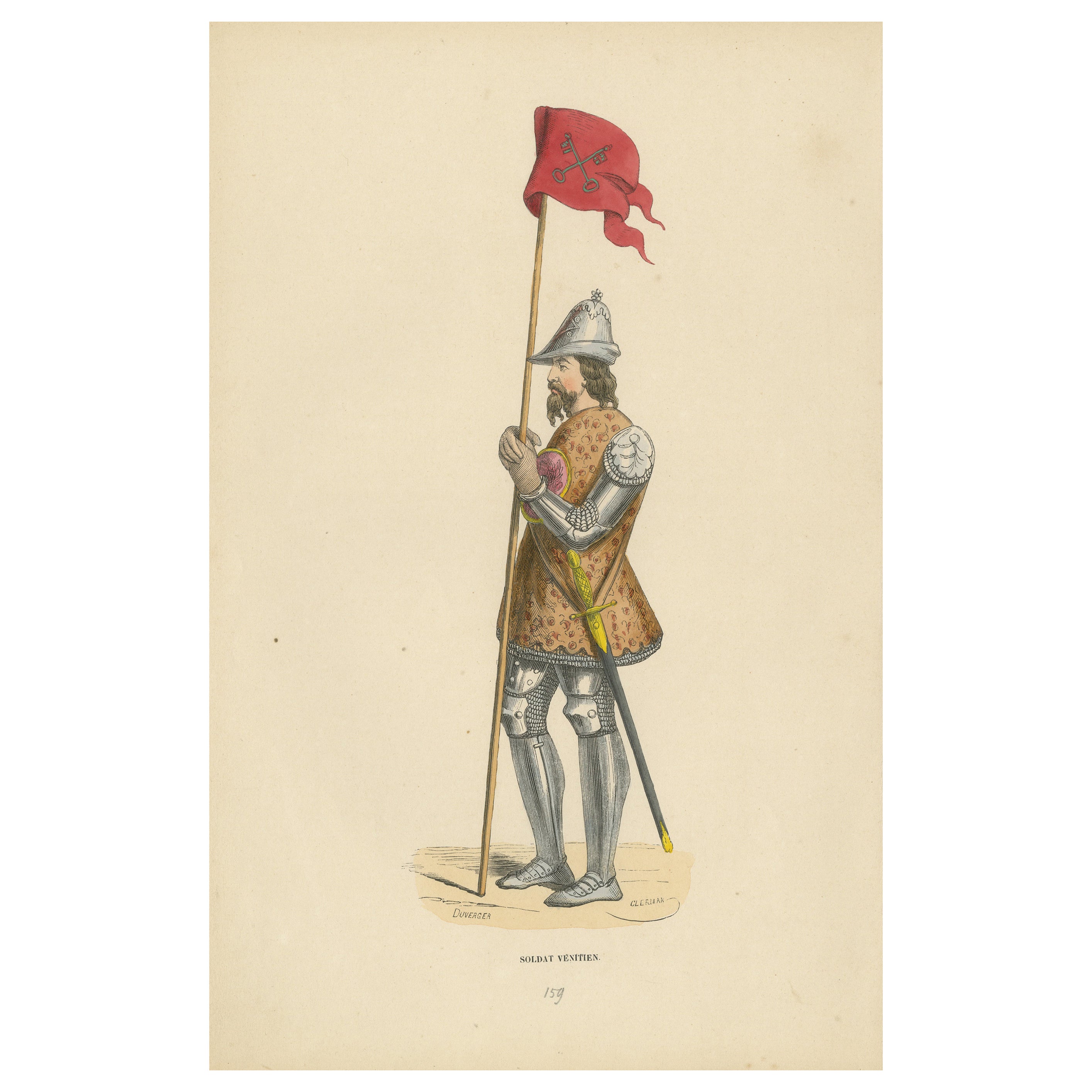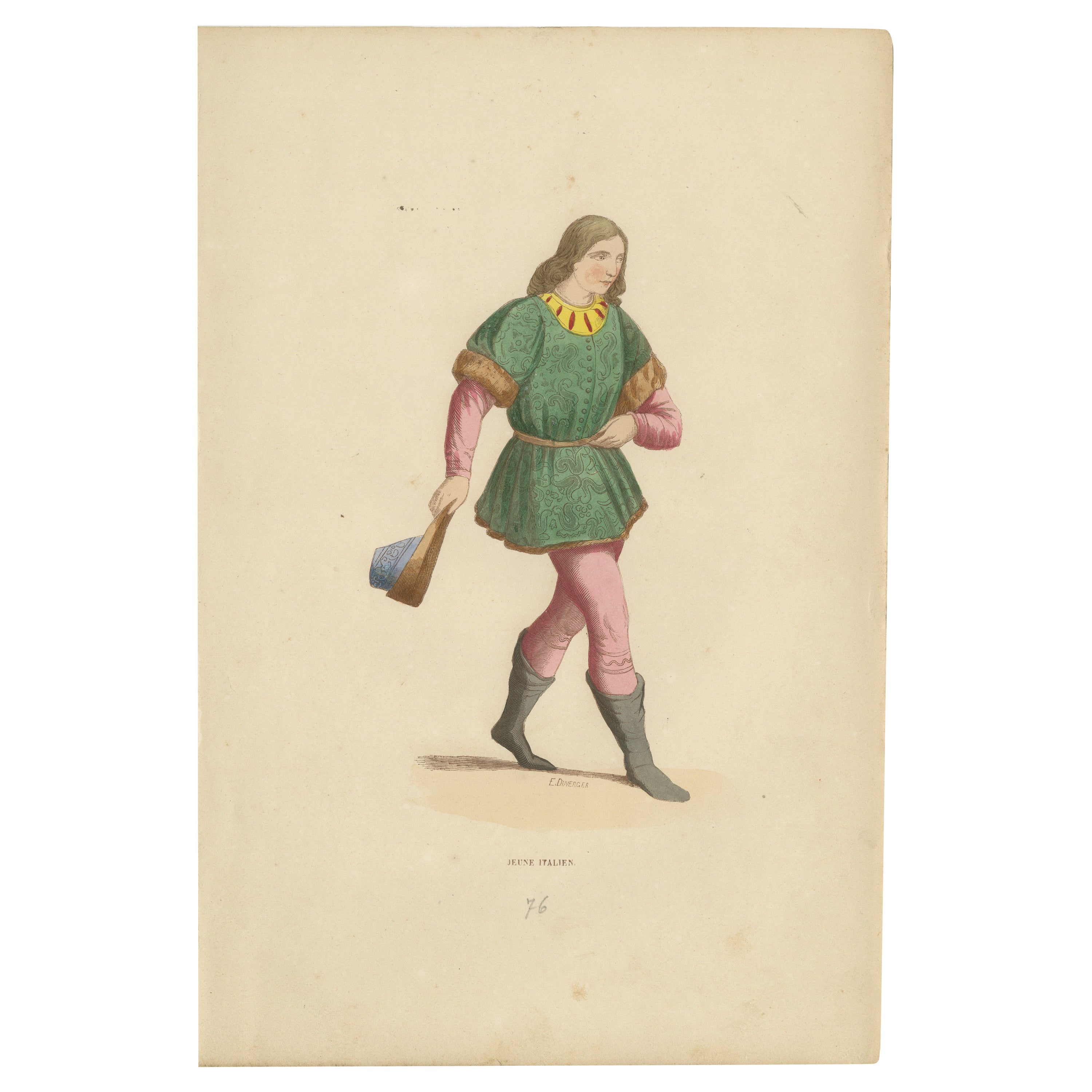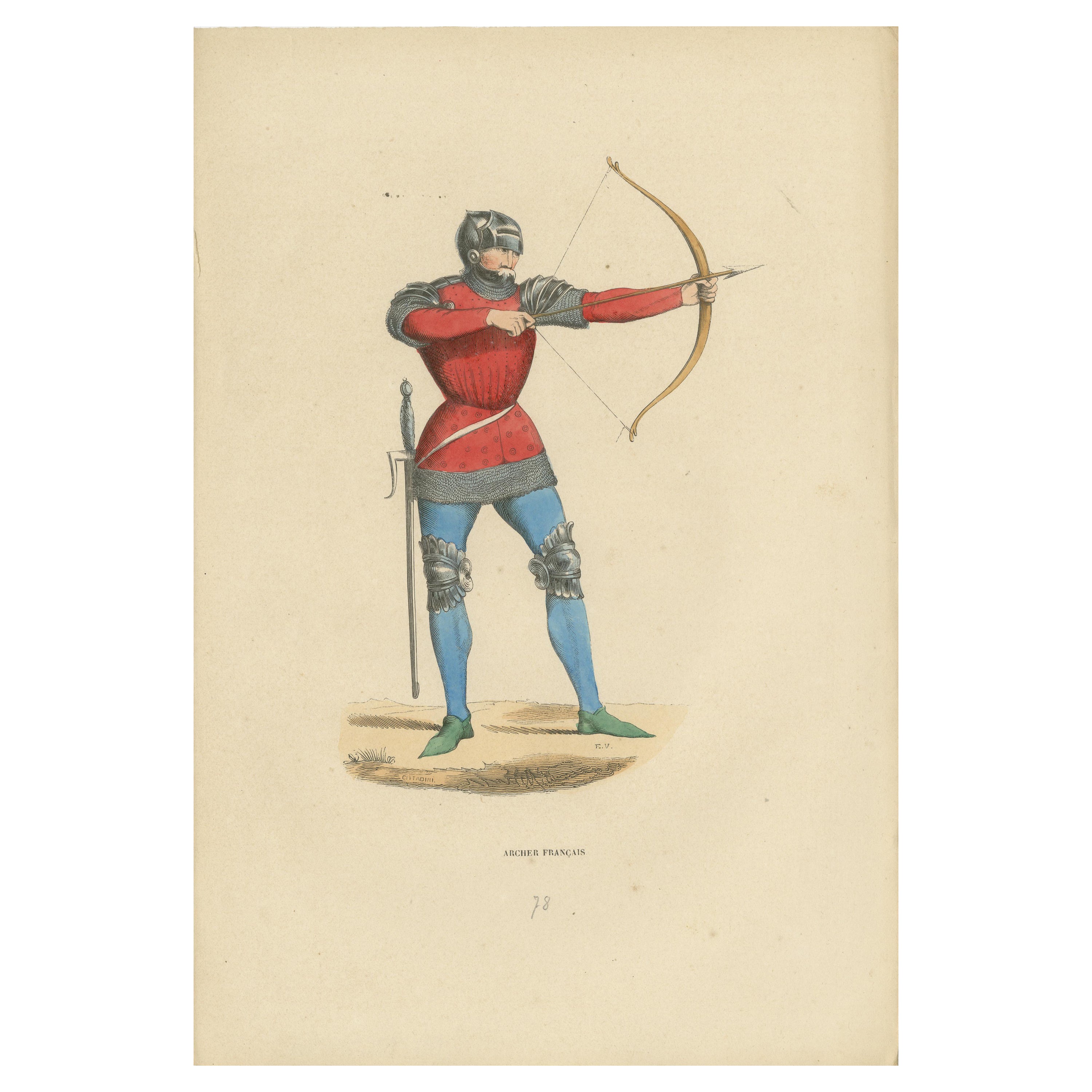Items Similar to The Italian Archer: A Study in Renaissance Military Fashion, 1847
Want more images or videos?
Request additional images or videos from the seller
1 of 6
The Italian Archer: A Study in Renaissance Military Fashion, 1847
About the Item
Title: "The Italian Archer: A Study in Renaissance Military Fashion"
Description: This print showcases the garb of an Italian military archer, likely from the Renaissance period. The figure is turned slightly away, providing a profile view that highlights the intricate detailing of his attire. He is clad in a sleeveless doublet with ornate patterning, over which a lighter, armored vest is worn for protection. This is coupled with bright red hose, which were commonly worn by men of the era, and practical, dark shoes.
The archer's headgear is particularly noteworthy—a helmet adorned with a decorative plume, indicating a sense of style and perhaps a higher rank or specialized role within the military. His ready posture and the bow slung over his shoulder speak to his preparedness for battle or guard duty. The colors and design elements of his costume are indicative of the vibrant and elaborate fashion sensibilities of the time, reflecting a culture that valued the appearance of its military representatives as much as their effectiveness in combat.
The overall presentation is one of a soldier ready for service, yet also displaying the characteristic Renaissance attention to aesthetics and personal adornment..
The colors have a nice glow over them. Historically, egg whites, known as glair, and sometimes egg yolk were indeed used in illumination and painting, particularly in manuscripts, to give colors a brighter appearance and to add a sheen or gloss to the work. This technique was quite common during the Middle Ages and into the Renaissance.
Egg whites can be applied as a varnish over pigments to enhance their brightness and to protect the colors. This application could make the colors appear more vivid and also add a slight glossy sheen to the surface of the image.
Egg whites can be applied as a varnish over pigments to enhance their brightness and to protect the colors. This application could make the colors appear more vivid and also add a slight glossy sheen to the surface of the image.
Egg yolk, on the other hand, was commonly used as a binding agent in paint. It forms the basis of tempera paint, a medium that was widely used before the advent of oil painting. Egg yolk helps to create a durable and long-lasting color that adheres well to various surfaces.
In the context of the print from 1847, it's less likely that egg whites or yolks were used directly on the print, as by that time, commercial printing processes would have been more advanced and less reliant on such manual methods. However, if this print is a representation of an earlier style or is meant to mimic the appearance of hand-painted manuscripts, the original artists might have employed techniques or materials that gave a similar effect to those achieved with egg-based binders and varnishes.
- Dimensions:Height: 10.63 in (27 cm)Width: 7.09 in (18 cm)Depth: 0 in (0.02 mm)
- Materials and Techniques:
- Period:
- Date of Manufacture:1847
- Condition:Good. Overal light toning and light soiling but the image itself clean and hand-colored almost 200 years ago and still in expliciet colors. Aged paper with typically warm, yellowish-brown hue, mostly around the edges. Study the images carefully.
- Seller Location:Langweer, NL
- Reference Number:
About the Seller
5.0
Platinum Seller
These expertly vetted sellers are 1stDibs' most experienced sellers and are rated highest by our customers.
Established in 2009
1stDibs seller since 2017
1,928 sales on 1stDibs
Typical response time: <1 hour
- ShippingRetrieving quote...Ships From: Langweer, Netherlands
- Return PolicyA return for this item may be initiated within 14 days of delivery.
More From This SellerView All
- Elegant Renaissance Italian Youth Fashion, Published and Hand-Colored in 1847Located in Langweer, NLDescription: This original antique print, labeled "Jeune Italien, No. 2," which translates to "Italian Youth, No. 2," depicts a young man in what appears to be a Renaissance-period a...Category
Antique 1840s Prints
MaterialsPaper
- Standard-Bearer of Venice: Military Splendor of the Renaissance, 1847Located in Langweer, NLThis is an illustration of a soldier from Venice, known as a "Soldat Vénitien." The image is likely from a historical or military costume book, detailing the dress and equipment of v...Category
Antique 1840s Prints
MaterialsPaper
- Renaissance Youth: The Italian Page in a Hand-Colored Engraving, 1847Located in Langweer, NLTitle: "Renaissance Youth: The Italian Page" Description: This print depicts a young Italian page, a common figure in Renaissance courts, whose duties often included serving nobilit...Category
Antique 1840s Prints
MaterialsPaper
- Scholar of the Codex: A Medieval Jurist in Study, 1847Located in Langweer, NLThe image depicts a person labeled "Docteur des Lois," which translates to "Doctor of Laws." This term historically refers to an individual who has achieved advanced scholarly status in the field of law, equivalent to the modern term "Juris Doctor." The figure is seated at a lectern, deeply engrossed in a large book, which likely represents legal texts or scholarly works. The individual is attired in a robe with a fur-lined cape, suggesting a status of academic or professional distinction. The robe is red, a color often associated with higher education and learning. The headwear appears to be a type of turban, which was a common academic regalia in certain cultures and times. The setting and attire suggest that this person is a scholar or a high-ranking legal professional, possibly a university professor or a magistrate from the medieval or Renaissance period. Egg whites can be applied as a varnish over pigments to enhance their brightness and to protect the colors. This application could make the colors appear more vivid and also add a slight glossy sheen to the surface of the image. Egg yolk, on the other hand, was commonly used as a binding agent in paint. It forms the basis of tempera paint, a medium that was widely used before the advent of oil painting. Egg yolk helps to create a durable and long-lasting color that adheres well to various surfaces. In the context of the print from 1847, it's less likely that egg whites or yolks were used directly on the print, as by that time, commercial printing processes would have been more advanced and less reliant on such manual methods. However, if this print is a representation of an earlier style or is meant to mimic the appearance of hand-painted...Category
Antique 1840s Prints
MaterialsPaper
- Old Engraving of The French Archer: Precision and Readiness, 1847Located in Langweer, NLTitle: "The French Archer: Precision and Readiness" Description: This print depicts a French archer, possibly from the late Middle Ages, demonstrating his skill and readiness for combat. The archer is in a dynamic stance, captured in the moment of drawing his bow, a testament to his expertise and role as a crucial member of the military during this era. He is dressed in a red gambeson, a padded defensive jacket that was commonly worn under armor...Category
Antique 1840s Prints
MaterialsPaper
- The Gallant Courtier: A Nobleman's Fashion in 'Costume du Moyen Âge, 1847Located in Langweer, NLTitle: "The Gallant Courtier: A Nobleman's Fashion in 'Costume du Moyen Âge'" Description: This 1847 lithograph from the "Costume du Moyen Âge" collection depicts a nobleman dressed...Category
Antique 1840s Prints
MaterialsPaper
You May Also Like
- Archer PrintBy Maurice LangaskensLocated in Napa, CAWonderful print by Maurice Langaskens, circa 1940, depicting a group of three men engaged in archery.Category
Vintage 1940s Belgian Prints
- Military Print, The Gunner By SnafflesLocated in Oxfordshire, GBSnaffles WWI Military Print, The Gunner. A good Snaffles WWI military print entitled 'The 'Gunner', it is a hand coloured lithograph and shows the Gunner looking up at a passing plan...Category
Vintage 1910s British Sporting Art Prints
MaterialsPaper
- Snaffles Print, WW1 Military Print, the 'D.R.'By Charles "Snaffles" Johnson PayneLocated in Oxfordshire, GBVintage Snaffles WWI Military Print, The D.R. A good hand coloured Snaffles WWI military print 'The D.R.'. The main center colour-piece image is mounted onto the printed remarque boa...Category
Early 20th Century English Prints
MaterialsPaper
- Signed Snaffles WWI Military Print, The GunnerBy Charles "Snaffles" Johnson PayneLocated in Oxfordshire, GBSnaffles WWI Military Print, The Gunner. A good Snaffles WWI military print entitled 'The 'Gunner' with artist signature in pencil in the bottom right-...Category
20th Century British Prints
MaterialsPaper
- Vanity Fair, Military Print, the Cavalry DivisionBy Godfrey Douglas GilesLocated in Oxfordshire, GBVanity fair military print 'the Cavalry Division' after G.D.G. A chromolithograph military print published 12th July, 1900, by Vincent Brooks, Day & S...Category
20th Century British Sporting Art Prints
MaterialsPaper
- John James Audubon "The Little Owl, " 1834 Havell Edition in Renaissance FrameBy Robert Havell, John James AudubonLocated in Brooklyn, NYCreated as part of John James Audubon's "The Birds of North America," the single greatest work on ornithology ever produced, this rare print of "The Little Owl, Strix Acadica" is presented in its original full elephant folio size. Audubon traveled extensively throughout the young United States recording every then known species of bird in 435 plates, each in their true to life scale. From the very rare Havell edition...Category
Antique 1830s American American Classical Prints
MaterialsGlass, Giltwood, Paper





